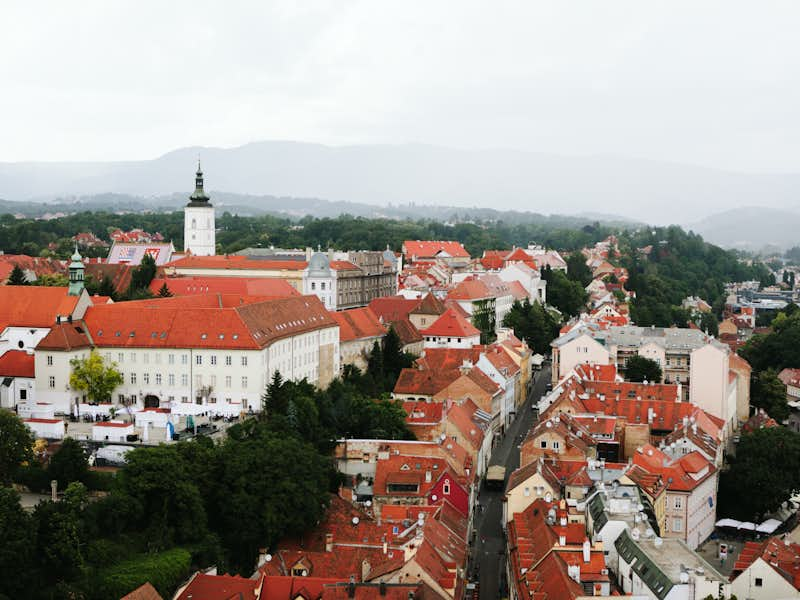Zagreb
For the first two months, students will live in Zagreb, the capital of Croatia. The city has a vibrant and inviting intellectual and artistic culture, with many seasonal festivals, theaters, music clubs, museums and libraries. It is a city in which walking, biking or taking a tram is a preferred form of transportation, the open market is a preferred way of shopping, and sitting in the outdoor cafes is a favorite pastime. Students have found that Zagreb is a city where one quickly feels at home.
Founded in 1094, Zagreb has a long history at the margins of Europe. Its architecture betrays its past as a Central European city under the rule of the Habsburgs. Its buildings show all the trends of 18th, 19th and 20th-century European architecture—with its Neo-Gothic cathedral, its Neo-Baroque National theatre and a string of parks and promenades laced with cafes.
Zagreb will serve as a home base from which we will take day and weekend trips to areas that were ravaged by and are still recovering from the war, like Osijek, Vukovar and Slunj.
Serbia & Bosnia-Herzegovina
Early in the third month, we will leave Zagreb for a 10-day sojourn through the Balkans. This will include extended stays in Belgrade (the capital of Serbia), Mitrovica (a city at the heart of the struggle between Serbia and the Republic of Kosovo), Sarajevo (the capital of Bosnia and Herzegovina that endured 4 year siege that resulted in 15,000 dead civilians), and Mostar (a city in Herzegovina, divided between Croats and Moslems and struggling to find a lasting peaceful solution).
Vis
Our journey will conclude on the island of Vis in the town of Komiza. An island in the Adriatic Sea off the coast of Croatia, Vis is surrounded by crystal blue water, and peppered with inviting beaches and ancient stone villages. The island serves as an ideal location for studying and reflecting, and for enjoying the Mediterranean side of the Balkans. In addition to its beauty, Vis is also strategically important. Since before the time of its Greek inhabitants, it was considered a gateway to the Adriatic Sea. Throughout western history, important ship battles took place there and various militaries vied for control of the island. More recently, from 1945-1991, the island was closed to visitors while it served as a key naval base for the Yugoslav National Army.
A Region of Conflict
"The Balkans is the most recent European area to shed—literally and painfully—the legacy of the Second World War, but this region is also the most ancient. Three empires coincide in it (the Ottoman, the Italian, the Austro-Hungarian), not to mention the power grabs by 20th Century tyrannies. Three religions uneasily make their home there… Everywhere one turns, history speaks."
Caryl Emerson|Princeton University
This program will focus on the region of the Balkans that encompasses states inhabited primarily by the South Slavic people. Although many areas have recovered from the wars that took place in the 1990s, the people throughout the region are struggling to find a way forward and to learn how to live among neighbors whom until recently were enemies.
The very name Balkans evokes the notion of war, conflict and division. Indeed, for centuries the Balkans have been the site in which western and eastern forces such as the Austro-Hungarian and Ottoman Empires fought for dominance and expansion. WWI famously started in Sarajevo with the assassination of Archduke Ferdinand. But the Balkans is also one of the most ethnically and religiously diverse regions of Europe. It is here that the questions of being at peace or at war with those other than oneself—ethnically, religiously, culturally—are ever present and where stories of success and failure are played out as a serious drama with life or death consequences.
The most recent conflicts in the Balkans started in the 1990's when two of the Republics within the Federative Republic of Yugoslavia, Croatia and Slovenia, decided to cede. The regime in Belgrade (then the capital of both Yugoslavia and Serbia), with Slobodan Milosevic at the helm, was opposed to secession and used the Yugoslav army to gain control over portions of Croatia. From here the war spread to another of the Yugoslav republics—Bosnia and Herzegovina, where it raged until December of 1995. The war in Bosnia produced the worst crimes on European soil since WWII, including the genocide of Srebrenica and the four-year Siege of Sarajevo. Prior to the war, Bosnia was a multiethnic state with three major ethnicities: Moslem Bosniaks (44%), Orthodox Serbs (31%) and Catholic Croats (17%). All three sides were in conflict at different points throughout the four years of fighting, and this is reflected in the current struggles for peace.
Have any questions? We're here to help.
Global Education Office
MacDonald Hall 130
